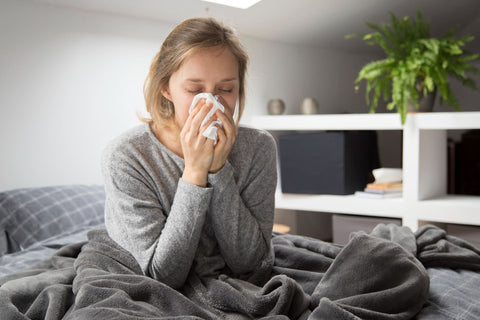Migraine is a condition that produces recurring and severe headaches (usually one-sided). The pain is often pulsating, accompanied by nausea and vomiting, noise sensitivity and sensitivity to flashing lights, lasting for a few hours to a few days.
Migraines are a common health condition, especially among women. It is estimated that around one in every five women in the UK suffer from migraines. Some individuals have migraines several times a week, while others experience them occasionally.
Pathophysiology Of Migraine
It is believed that migraines are linked to a drop in the level of serotonin, a neurotransmitter in the brain causing a widening in the blood vessels. This puts pressure on our nerve fibres, forcing them to release peptides, which travel to the brain's outer covering, leading to inflammation and migraine pain.
One of the arguments used to prove this idea is the fact that the level of serotonin decreases during migraine headaches, whereas an intravenous infusion of serotonin can stop it.
According to another theory, migraines may also be caused by vascular abnormalities mainly contractions and dilations of blood vessels in the brain. This is also triggered by serotonin and other neurotransmitter abnormalities, for instance, increased levels of glutamate which cause vasodilation.
Although it is still controversial whether migraines are primarily a vascular problem (dilation of blood vessels) or neurological dysfunction, both may play a significant role in the development of migraine headaches.
Both factors (vascular and neurological) are likely to be triggered by various types of inflammation in the body and possibly other lifestyle and environmental causes.
Possible Causes and Triggers
A drop in neurotransmitters, especially serotonin, low levels of other inhibitory neurotransmitters, such as acetylcholine (vasoconstrictor) or dopamine, and an increase in excitatory neurotransmitters such as glutamate (causes vasodilation) also contribute to migraine.
- High levels of inflammation in the body
- Caffeine, wine (sulphites), beer, cheese, pizza, gluten, chocolate, sugar, white flour products and other refined foods, additives, proinflammatory omega-6 fatty acids, refined commercial oils (sunflower oil, soya oil, vegetable oil, corn oil), processed foods and carbonated drinks
- Monosodium glutamate (MSG) increases oxidative stress and is a known migraine trigger
- Deficiency of Magnesium, B2, B3, B12 and Zinc
- Psychological stress, depression, anxiety
- Aspartame and sucralose
- Certain medications
- Deficiency of CoQ10 and Lipoic Acid
- Allergies and food sensitivity
- Nitrates in meat products
- Hormonal imbalances such as low oestrogen and progesterone
- Hypoxia (lack of oxygen), mainly caused by a lack of physical activity and shallow breathing
- Hypoglycaemia (low blood glucose levels)
- Drop in barometric pressure
- Lack of sleep
- Dehydration caused by drinking an insufficient amount of water and consuming a diet low in fruits and vegetables
- Pineal gland calcification (hardening of the pineal gland, caused by fluoride)
- Constipation
Serotonin and Maigraines
Studies have found that an increased brain synthesis of serotonin offers natural relief for migraine symptoms, including pain.
Serotonin aids in relieving migraines because it prevents dilation and promotes constriction of blood vessels. Studies have proven the link between migraines and low serotonin levels in the brain. The link is so strong that some researchers and experts have started referring to migraine headaches as “low serotonin syndrome.”
When someone is experiencing a migraine headache, the body dramatically increases urinary excretion of the main component of serotonin (5-Hydroxyindoleacetic acid), which results in low serotonin levels.
If it is true that serotonin deficiency is the most significant problem behind migraine headaches, those who suffer from this condition should do their best to increase levels of this neurotransmitter in the brain to prevent migraine or ease the symptoms.
In addition, since serotonin is also known for its ability to increase the body’s pain tolerance, raising its concentration in the brain should make migraine pain more manageable.
Fortunately, there are some simple means which are helpful and effective in raising brain levels of serotonin. One of the most important ways to achieve this goal is by providing the body with amino acid tryptophan, or even better 5HTP, which is made from tryptophan.
Because of its ability to boost serotonin levels, 5HTP synthesized from tryptophan, has been used to help individuals suffering from numerous disorders, including migraines, tension headaches, depression or anxiety.
It is very important to remember that enough vitamin C, B3, B6 (pyridoxine), Folate, Zinc, and Magnesium are necessary for the formation of tryptophan, which, in turn, is necessary in our body for the synthesis of serotonin.
Apart from that, it has been shown that Magnesium, Vitamin B6 and B3 can also assist in the conversion of tryptophan to serotonin.
It is true that tryptophan is also found in animal foods especially milk, but animal sources (including milk and dairy) are much higher in other competitive amino acids thus hindering absorption of tryptophan.
Because tryptophan is an amino acid (protein), a diet rich in other types of protein (meat and dairy products) delays tryptophan from passing from the blood to your brain.
This is because tryptophan must compete with many other amino acids (proteins) while trying to enter the brain, as a result, only a small amount of this amino acid enters.
That is another reason why it is much better to supplement tryptophan in the form of 5HTP instead of relying on animal foods. In addition, unlike 5HTP, meat and dairy products also present numerous high-risk health factors such as cholesterol, triglycerides and antibiotics.
Study by Professor J. Wurtman (2009) demonstrated that tryptophan, which is the building block of serotonin, can get into our brains only when sweet unrefined carbohydrates are consumed. Thus, more serotonin is made after you consume sweet unrefined carbohydrates such as fruits (especially bananas and dried fruits).
Numerous studies have demonstrated that the amino acid 5-HTP is used by the body to produce serotonin and is helpful in coping with migraines, obesity, insomnia, anxiety, and depression.
5-HTP is regarded as a potent antioxidant, able to protect the body against free radical damage, reducing the risk of numerous health problems such as cardiovascular diseases, fatigue and cancer.
In 1989, the U.S. Centers for Disease Control reported evidence linking L-tryptophan supplements to a disorder characterized by an elevated white blood cell count.
However, subsequent research showed that it was contaminants in the supplements, not the tryptophan, that was responsible for the problem.

L-tryptophan VS 5-HTP
Supplementing with L-tryptophan instead of 5-HTP is a much less effective way to increase serotonin levels because L-tryptophan must be converted to 5-HTP.
This means that taking L-tryptophan will result in producing less serotonin than supplementing 5-HTP. Both L-Tryptophan and 5-HTP must cross the blood-brain barrier to make serotonin in the brain.
However, unlike L-Tryptophan 5-HTP doesn’t have to compete with other amino acids to cross the blood-brain barrier. As a result, 5-HTP is much more effective in entering the brain. For this reason, 5-HTP is regarded as a more effective form of tryptophan in boosting brain serotonin levels.
The human body uses L-tryptophan to produce several compounds including Niacin (Vitamin B3), but 5-HTP is only used to produce serotonin and melatonin (from serotonin).
Your body can convert L-Tryptophan and 5-HTP to serotonin in the liver and the brain. Part of L-tryptophan can be converted to serotonin in the liver but, this serotonin can’t be used by the brain to improve mood or prevent migraine.
While supplementing with L-tryptophan and 5-HTP it is also very important to make sure that it is taken with Vitamin B3 and Vitamin B6.
Tryptophan is first converted in the liver into 5HTP (5-Hydroxy L-Tryptophan) by the enzyme tryptophan hydroxylase with the help of Vitamin B3 (niacin). The problem, however, is that when the liver attempts to convert tryptophan to 5HTP in the absence of adequate levels of Vitamin B3, it will use tryptophan to synthesise it.
It uses 60mg of tryptophan to produce 1mg of niacin, thus leading to tryptophan and serotonin deficiency!
On the other hand, when 5-HTP enters the liver, an enzyme (decarboxylase) converts it to 5HT, it can only do this effectively with the help of vitamin B6 (pyridoxine).
Unfortunately, when the body is deficient in this vitamin, the liver will convert 5HTP to some toxic metabolites!
Vitamin B2
Vitamin B2 (Riboflavin) supplementation seems to be beneficial in coping with migraine headaches. A 300-400mg daily dose of riboflavin was used in the studies below:
- A 2016 review concluded that daily doses of B2 may improve mitochondrial function, thereby preventing attacks and reducing the need for treatment.
- A 2004 study found that patients who took Riboflavin experienced significantly fewer headaches and used fewer migraine painkillers or could completely avoid medications.
- A 2015 trial of 55 migraine patients using Vitamin B2 showed decreased migraine ‘attack frequency’ and ‘headache days’.
- In 1998 a study of 80 patients with migraines found that those in the Riboflavin group experienced 50% fewer migraines and reduced the severity of pain than those in the placebo group.
- Vitamin B2 may be able to achieve similar results to prescription alternatives with much fewer problems, Riboflavin can be considered a safe and more natural alternative to meds
Other Serotonin Boosters
Apart from 5-HTP (tryptophan) and Vitamin B2, Vitamins C, B1, B3, B6, B12, D, Folic Acid, Calcium, Selenium, Zinc, and Magnesium, regular exercise, and sunlight are beneficial in increasing Serotonin levels
Lifestyle And Serotonin
In the book ‘The Natural Way to Overcome Depression, Obesity, and Insomnia’ Dr. Michael Murray wrote: “Bad diet, lack of exercise, use of harmful substances such as alcohol or caffeine (coffee, tea, cola drinks, etc.) can rob your brain of the ability to make enough serotonin.
This produces a range of significant complications: depression, obesity, insomnia, migraine headaches, or chronic fatigue.”
It means that to have more serotonin you must exercise and avoid stimulants such as alcohol and foods or drinks which contain caffeine (coffee, tea, cola drinks, etc.).
In January 2009 Psychopharmacology reported that stress greatly decreases serotonin levels.
If you want to have enough serotonin you should stay away from the low-calorie slimming diets as experiments with rats demonstrated that reducing calories in their diet decreased serotonin levels.
Instead, follow a normal-calorie unrefined plant-based diet, which is the most healthy and effective way to elevate serotonin levels in the body.
According to Harvard psychiatrist Joseph Glen Mullen serotonin can be enhanced by positive thinking, stress control, and by aerobic exercise such as brisk walking. Exercise can raise serotonin levels by both increasing the synthesis and release of it.
According to Dr. Sang Lee even looking at certain lights and colours such as blue or green can positively affect serotonin levels. That is why seeing the green colour of grass or trees and blue colour of the sky, ocean, lake, river, or even swimming pool water may positively influence serotonin levels.
It is now a well-documented scientific fact that it is the lack of light (especially during the winter season) which is responsible for causing a popular form of depression called SAD (Seasonal Affective Disorder) that occurs at the same time every year. For this reason, light therapy is used in this case with excellent results.
In one interesting experiment, scientists asked patients with depression to wake up early at 5 am, go out and expose themselves to the sunlight. As a result, their symptoms of depression disappeared.
They also demonstrated that the early morning sunlight was the most effective in fighting depression. However, to wake up early you should go to bed before 10 pm.
It was demonstrated that full-spectrum light stimulated chickens to release serotonin so well that they lived twice as long! In addition to that, they were also calmer and produced eggs which were much lower in cholesterol!
That is why when we expose our body to the sunlight, we feel more relaxed, have a stronger immune system and have lower cholesterol levels.
Non-full-spectrum lighting, which is often used in workplaces and our homes, has created stressful amounts of hormones such as cortisol and ACTH. On the other hand, artificial full-spectrum lighting, which imitates the natural light found in sunlight, can significantly improve our mood and energy level.
Some experts, however, conclude that it is not the type of light but its intensity which is more important as the therapeutic value comes from the brightness of the light.
They seem to agree that full-spectrum light is healthier, they suggest that any bright light therapy helps to decrease the symptoms of SAD, PMS, heart rhythm disorders, insomnia, or fibromyalgia and helps cope with obesity.
Unfortunately, for therapeutic purposes, we need very bright light, at least 2,500 lux. The stronger the light the better results can be achieved.
That is why it is so important to go for a walk and use the benefits of natural sunlight any time the weather is fine because even without direct sun the strength of light is 10,00025,000 lux, while in direct sunlight it is 32,000130,000 lux!
Even on a cloudy day, we have about 1,000 lux of light available. Unfortunately, the artificial light we have at home or work is usually only between 50 to 150 lux.
Related Articles
Sources
- Liebman, T. N., and Crystal, S. C. (2016). What Is the Evidence that Riboflavin Can Be Used for Migraine Prophylaxis?. Einstein Journal of Biology and Medicine, 27(1), 7-9.
- Schoenen J, Jacquy J, Lenaerts M. Effectiveness of high-dose riboflavin in migraine prophylaxis: A randomized controlled trial. Neurology. 1998;50(2):466–470.
- Rahimdel A, Zeinali A, Yazdian-Anari P, Hajizadeh R, Arefnia E. Effectiveness of Vitamin B2 versus Sodium Valproate in Migraine Prophylaxis: 2015 Oct 19;7(6):1344-8. doi: 10.14661/1344.
- Daniel, O., and Mauskop, A. (2016). Nutraceuticals in acute and prophylactic treatment of migraine. Current treatment options in neurology, 18(4), 14.
- https://www.migrainekey.com/migraine-trigger/glutamic-acid-glutamate/
- Li D, He L. Meta-analysis supports association between serotonin transporter (5-HTT) and suicidal behavior. Mol Psychiatry 2006; 12:47-54.
- 7 Foods That Could Boost Your Serotonin, Written by Healthline Editorial Team Medically Reviewed by Peggy Pletcher, MS, RD, LD, CDE on April 28, 2015
- Serotonin a la carte: supplementation with the serotonin precursor 5-hydroxytryptophan, EH Turner et al., Pharmacol Ther. 2006 Mar;109(3):325-38. Epub 2005 Jul 14.
- 5-HTP efficacy and contraindications, M Hinz, A Stein and T Uncini, Neuropsychiatr Dis Treat. 2012; 8: 323–328, Published online 2012 Jul 19. doi: 10.2147/NDT.S33259
- The function of serotonin within the liver, Ruddell, Richard G. et al., Journal of Hepatology , Volume 48 , Issue 4 , 666 - 675
- Michael T. Murray (1998). 5-HTP: The Natural Way to Boost Serotonin and Overcome Depression, Obesity, and Insomnia. June 1st 1998 Bantam.
- Hirsch M, et al. Unipolar depression in adults and selective serotonin reuptake inhibitors (SSRIs): Pharmacology, administration and side effects. uptodate.com/home. Accessed June 5, 2013.
- Young SN (2007). “How to increase serotonin in the human brain without drugs”. J Psychiatry Neurosci 32 (6): 3949. PMC 2077351. PMID 18043762.
- Martinez A, Knappskog PM, Haavik J. A structural approach into human tryptophan hydroxylase and its implications for the regulation of serotonin biosynthesis. Curr Med Chem 2001 Jul; 8(9): 1077-91. 2001. PMID: 15980.
- Moore P, Landolt HP, Seifritz E, et al. Clinical and physiological consequences of rapid tryptophan depletion. Neuropsychopharmacology 2000 Dec; 23(6): 601-22. 2000. PMID: 16020.
- University Of Pennsylvania School Of Medicine (2005, July 11). Mood Lighting: Penn Researchers Determine Role Of Serotonin In Modulating.
- Taking Antidepressants: Your Comprehensive Guide to Starting, Staying On, and Safely Quitting, by Michael D. Banov, M.D. (Sunrise River Press, 2010).
- The Antidepressant Solution: A Step-by-Step Guide to Safely Overcoming Antidepressant Withdrawal, Dependence, and “Addiction,” by Joseph Glenmullen, M.D. (Free Press, 2006).
- Curr Opin Neurobiol. 2013 Feb 2. pii: S0959-4388 (13) 00027-5.
- J Nutr. 2012 Dec; 142(12):2236S-2244S.
Images: Head pain photo created by wayhomestudio - www.freepik.com Image by Freepik
Any information or product suggested on this website is not intended to diagnose, treat, cure or prevent any medical condition. Never disregard medical advice or delay in seeking it because of something you have read on this website. Consult your primary healthcare physician before using any supplements or making any changes to your regime.





